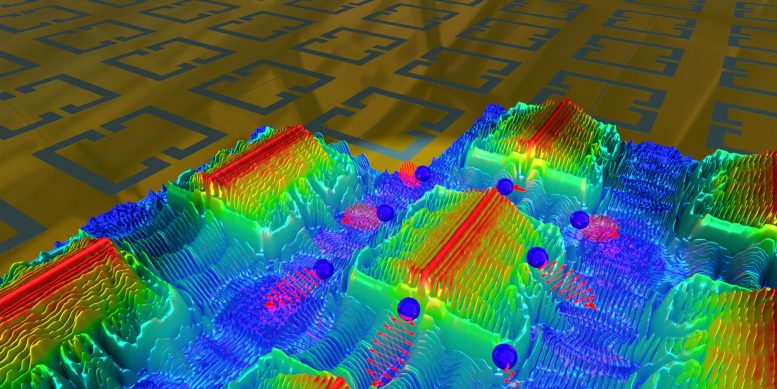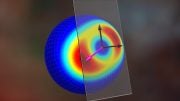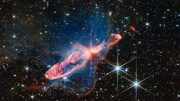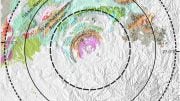
Metasurface of split-ring resonators, partially overlaid with 3D colormaps showing the simulated electric-field distribution. High-momentum magnetoplasmons lead to the break-down of polaritons (blue spheres with photon energies in red). Credit: Urban Senica, ETH Zurich
Physicists from the University of Southampton and ETH Zürich have reached a new threshold of light-matter coupling at the nanoscale.
The international research, published recently in Nature Photonics, combined theoretical and experimental findings to establish a fundamental limitation of our ability to confine and exploit light.
The collaboration focused on photonic nano-antennas fabricated in ever reducing sizes on the top of a two-dimensional electron gas. The setup is commonly used in laboratories all over the world to explore the effect of intense electromagnetic coupling, taking advantage of the antennas’ ability to trap and focus light close to electrons.
Professor Simone De Liberato, Director of the Quantum Theory and Technology group at the University of Southampton, says: “The fabrication of photonic resonators able to focus light in extremely small volumes is proving a key technology which is presently enabling advances in fields as different as material science, optoelectronics, chemistry, quantum technologies, and many others.
“In particular, the focussed light can be made to interact extremely strongly with matter, making electromagnetism non-perturbative. Light can then be used to modify the properties of the materials it interacts with, thus becoming a powerful tool for material science. Light can be effectively woven into novel materials.”
Scientists discovered that light could no longer be confined in the system below a critical dimension, of the order of 250nm in the sample under study, when the experiment started exciting propagating plasmons. This caused waves of electrons to move away from the resonator and spill the energy of the photon.
Experiments performed in the group of Professors Jérôme Faist and Giacomo Scalari at ETH Zürich had obtained results that could not be interpreted with state-of-the-art understanding of light-matter coupling. The physicists approached Southampton’s School of Physics and Astronomy, where researchers led theoretical analysis and built a novel theory able to quantitatively reproduce the results.
Professor De Liberato believes the newfound limits could yet be exceeded by future experiments, unlocking dramatic technological advances that hinge on ultra-confined electromagnetic fields.
Read Exploring the Quantitative Limits of Light–Matter Coupling at the Nanoscale for more on this research.
Reference: “Polaritonic nonlocality in light–matter interaction” by Shima Rajabali, Erika Cortese, Mattias Beck, Simone De Liberato, Jérôme Faist and Giacomo Scalari, 9 August 2021, Nature Photonics.
DOI: 10.1038/s41566-021-00854-3









Sᴛᴀʀᴛ ᴡᴏʀᴋɪɴɢ ғʀᴏᴍ ʜᴏᴍᴇ! Gʀᴇᴀᴛ ᴊᴏʙ ғᴏʀ Ever, sᴛᴀʏ-ᴀᴛ-ʜᴏᴍᴇ ᴍᴏᴍs ᴏʀ ᴀɴʏᴏɴᴇ ɴᴇᴇᴅɪɴɢ ᴀɴ ᴇxᴛʀᴀ ɪɴᴄᴏᴍᴇ… Yᴏᴜ ᴏɴʟʏ ɴᴇᴇᴅ ᴀ ᴄᴏᴍᴘᴜᴛᴇʀ ᴀɴᴅ ᴀ ʀᴇʟɪᴀʙʟᴇ ɪɴᴛᴇʀɴᴇᴛ ᴄᴏɴɴᴇᴄᴛɪᴏɴ… Mᴀᴋᴇ $100 ʜᴏᴜʀʟʏ ᴀɴᴅ ᴜᴘ ᴛᴏ $13000 ᴀ ᴍᴏɴᴛʜ ʙʏ ғᴏʟʟᴏᴡɪɴɢ connection ᴀᴛ ᴛʜᴇ ʙᴏᴛᴛᴏᴍ .Yᴏᴜ ᴄᴀɴ ʜᴀᴠᴇ ʏᴏᴜʀ ғɪʀsᴛ ᴄʜᴇᴄᴋ ʙʏ ᴛʜᴇ ᴇɴᴅ ᴏғ ᴛʜɪs ᴡᴇᴇᴋ►►► 𝐖𝐰𝐰.𝐄𝐱𝐭𝐫𝐚𝐑𝐢𝐜𝐡𝟏.𝐜𝐨𝐦